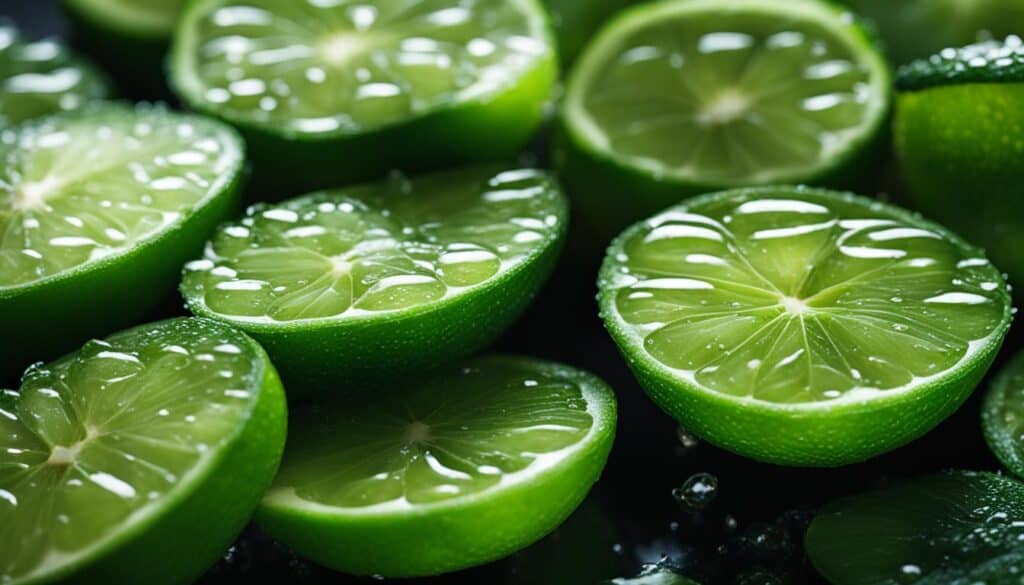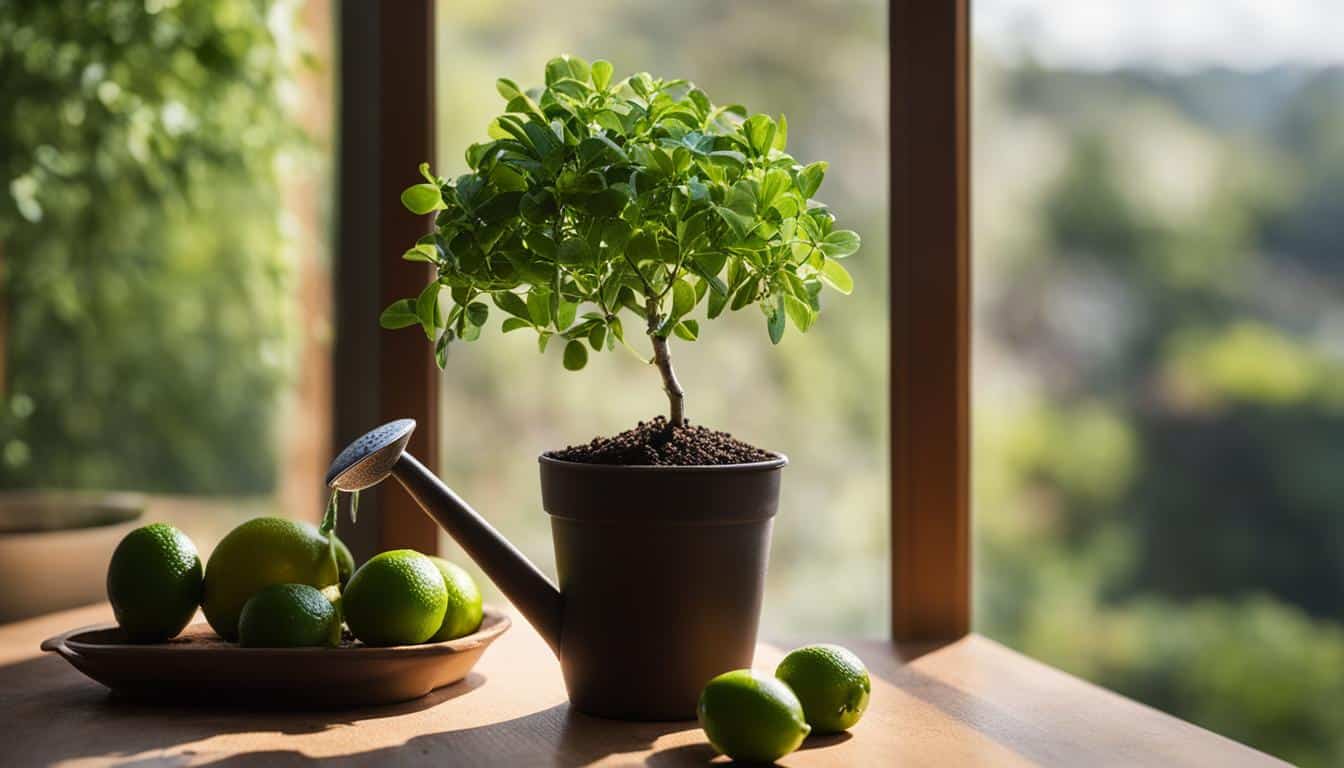Growing your own finger lime tree can be a rewarding and enjoyable experience. Not only will you have access to the unique and refreshing flavor of finger limes, but the process of cultivating these trees is surprisingly easy. Whether you have a spacious backyard or a cozy balcony, you can successfully grow a finger lime tree.
So, why should you consider growing a finger lime tree? These small fruits, also known as Australian Finger Limes or Caviar Limes, are gaining popularity in the culinary world for their distinctive texture and taste. Imagine the burst of flavor as you bite into a finger lime, releasing tiny juicy vesicles.
Now, let’s explore the fascinating world of finger lime trees and discover how you can easily grow your own.
Key Takeaways:
- Growing a finger lime tree is a rewarding and enjoyable experience.
- Finger limes are known for their unique texture and burst of refreshing flavor.
- You can easily grow a finger lime tree in your backyard or even in containers.
- Finger lime trees produce small finger-like fruits with juice-filled vesicles.
- By following simple care and maintenance practices, your finger lime tree will thrive and provide you with delicious fruits.
What is a Finger Lime Tree?
The finger lime tree, also known as the Australian Finger Lime or Caviar Lime, is a native citrus tree to Australia. It is a small evergreen tree that can reach a height of up to 20 feet. The finger lime tree produces elongated fruits that resemble fingers, with a length of about 2-3 inches. These fruits contain small juice-filled vesicles, often referred to as “lime caviar,” which burst with flavor when eaten.
There are several finger lime varieties available, each with its own unique characteristics. Some varieties have pearls or vesicles that are green, while others may have pink, red, or even black pearls. The color of the pearls does not affect the taste but adds aesthetic appeal to the fruit. The flesh of the finger lime can range from pale green to pink, and the fruit can have a tart or tangy flavor depending on the variety.
The finger lime tree is a popular choice for gardeners and culinary enthusiasts due to its distinctive appearance and flavor. It can be grown in subtropical and tropical climates, as well as in containers for colder regions. With its striking fruits and versatility in the kitchen, the finger lime tree is a fascinating addition to any citrus collection.
Finger Lime Varieties
| Variety | Pearl Color | Flesh Color | Flavor |
|---|---|---|---|
| Rainbow | Green, Pink, Red, Black | Pink | Tangy |
| Australian Red Center | Green | Red | Tart |
| Pearl | Pink | White | Mild |
These are just a few examples of the finger lime varieties available. Each variety has its own unique characteristics, allowing you to explore different flavors and appearances when growing your own finger lime tree.
How to Plant a Finger Lime Tree

Growing a finger lime tree is a rewarding experience that requires proper cultivation, care, and maintenance. Here are the essential steps to successfully plant a finger lime tree:
1. Choose the Right Location
Select a sunny and warm location with good soil drainage for your finger lime tree. The tree requires at least 6 hours of direct sunlight per day to thrive. Ensure that the soil is well-draining, as finger lime trees prefer slightly acidic to neutral soil pH.
2. Planting in Containers or Ground
Finger lime trees can be planted in containers or directly in the ground. If planting in containers, choose a large pot with good drainage and fill it with a potting mix formulated for citrus trees. When planting in the ground, dig a hole that is spacious enough to accommodate the tree’s root ball. Make sure to avoid burying the graft union, as this can lead to tree damage.
3. Watering and Fertilization
Water your finger lime tree regularly to keep the soil evenly moist but not waterlogged. During the spring and summer, provide moderate watering and reduce it during the dormant period. Fertilize the tree every 6 weeks with a balanced citrus fertilizer to ensure healthy growth and fruit production.
4. Pruning and Pest Control
Prune your finger lime tree after harvesting to maintain its shape and remove any dead, damaged, or crossing branches. Beware of the thorns and wear protective gear when pruning. Regularly inspect the tree for pests and diseases, and take necessary measures to control them.
By following these steps, you can successfully plant a finger lime tree and enjoy its delicious fruits for years to come. Remember to provide proper care and maintenance to ensure the tree’s health and productivity.
Growing Conditions for Finger Lime Trees
When it comes to growing finger lime trees, providing the right conditions is key. These trees thrive in partial to full sun, requiring at least 6 hours of direct light per day. Aim to plant them in an area that receives ample sunlight to ensure proper growth and fruit production.
Finger lime trees are well-suited to temperatures above 90°F during the summer, and they prefer mild winters with temperatures above 40°F. These trees can tolerate a wide range of soil types, but it’s essential to ensure that the soil is well-draining. Finger lime trees prefer slightly acidic to neutral soil pH, so consider testing the soil and making adjustments if necessary.
Another important factor to consider is protection from the wind. Finger lime trees have thorns and delicate fruit, which can be damaged by strong winds. Planting them in a sheltered location or using windbreaks can help safeguard your trees and promote healthy growth.
Table: Ideal Growing Conditions for Finger Lime Trees
| Light | Temperature | Soil | Wind Protection |
|---|---|---|---|
| Partial to full sun (at least 6 hours of direct light per day) | Above 90°F during summer, above 40°F during winter | Well-draining, slightly acidic to neutral pH | Plant in a sheltered location or use windbreaks |
By providing the correct growing conditions, you can help ensure the success of your finger lime trees. Remember to give them plenty of sunlight, protect them from harsh winds, and provide well-draining soil with the right pH levels. With these considerations in mind, your finger lime trees will be on their way to thriving and producing delicious fruits for you to enjoy.
Propagation of Finger Lime Trees

Propagating finger lime trees is a fascinating process that allows you to expand your citrus garden. There are two main methods of propagation: grafting onto rootstock seedlings and using rooted cuttings. Both methods have their benefits and considerations, so let’s explore them further.
Grafted Finger Lime Trees
Grafted finger lime trees are the preferred choice for propagation due to their numerous advantages. Grafting involves joining a scion, which is a piece of the desired finger lime variety, onto the rootstock of another citrus tree. This method provides several benefits, including disease resistance, cold tolerance, and control over the tree’s height.
By grafting, you can ensure that the new tree inherits the desirable traits of the scion, making it more likely to thrive in your specific climate. Additionally, grafted finger lime trees tend to produce fruit earlier compared to those grown from seeds or cuttings.
Rooted Cuttings
Rooted cuttings are another way to propagate finger lime trees, particularly if you’re looking to grow them in containers. This method involves taking a cutting from an existing finger lime tree and encouraging it to develop roots. Rooting hormone can be used to increase success rates.
Rooted cuttings are more suitable for container planting because they allow for greater control over the tree’s size and shape. However, it’s important to note that cuttings may take longer to establish and start producing fruit compared to grafted trees.
Both methods of propagation require care and patience, but they offer rewarding results. Whether you choose to graft or use cuttings, you’ll have the joy of watching your finger lime tree grow and thrive, providing you with an abundant harvest of these unique citrus gems.
| Method | Advantages | Considerations |
|---|---|---|
| Grafted Finger Lime Trees | – Disease resistance – Cold tolerance – Controlled tree height – Early fruit production | – Requires grafting skills – Cost of purchasing rootstock seedlings |
| Rooted Cuttings | – Control over tree size – Suitable for container planting | – Longer establishment period – Delayed fruit production |
Pruning and Maintenance of Finger Lime Trees
Pruning for Healthy Growth
Pruning plays a crucial role in maintaining the health and productivity of finger lime trees. Regular pruning helps improve air circulation, sunlight penetration, and overall tree shape. It also helps in removing dead or damaged branches and encourages new growth.
When pruning finger lime trees, it’s important to wear protective gear, including gloves and long sleeves, to safeguard against the tree’s thorns. Begin by removing any low-lying branches and those crossing each other, as they can hinder proper growth. Trim back any dead or diseased branches to prevent the spread of infections.
Additionally, pruning after each harvest season allows for easier access to the fruit and helps the tree redirect its energy towards new growth. Remember not to remove flowering or fruit-bearing branches during pruning, as this can negatively impact future yields.
Maintenance and Pest Control
To ensure the optimal health of your finger lime tree, regular maintenance is key. Start by providing ample water, especially during dry spells, while avoiding overwatering, which can lead to root rot. Additionally, applying a balanced fertilizer every six weeks during the growing season can provide the necessary nutrients for healthy growth.
It is important to monitor your finger lime tree for pests and diseases such as aphids, scale insects, or citrus canker. Regularly inspect the foliage, stems, and fruit for any signs of infestation or infection. If detected, take appropriate measures such as using organic pesticides or seeking professional advice to mitigate the issue.
By implementing proper pruning techniques and regular maintenance, you can ensure the long-term health and productivity of your finger lime tree, allowing you to enjoy its bountiful harvest for years to come.
Harvesting and Storing Finger Limes

Harvesting finger limes is an exciting moment for any finger lime tree owner. When the finger limes are fully ripe, they can be easily detached from the tree. It’s important to wait until they are fully ripe before harvesting, as finger limes do not ripen off the tree. The ripe fruit will have a vibrant color and a slightly soft texture when gently squeezed.
To harvest the finger limes, simply hold the fruit at the base and twist gently to detach it from the tree. The finger limes can be stored in a cool, dry place for up to a week, allowing you to enjoy them fresh. If you have a bountiful harvest and want to store them for a longer period, you can freeze them. Simply cut the finger limes in half or squeeze out the pulp into a freezer-safe container, and store them in the freezer for up to six months. Freezing helps preserve the flavor and texture of the finger limes, allowing you to enjoy them throughout the year.
“The finger limes can be stored in a cool, dry place for up to a week, allowing you to enjoy them fresh.”
When handling finger limes, it’s important to take precautions due to the thorns on the tree. Wear gloves and protective clothing to avoid any injuries during the harvesting process. The thorns can be sharp, but with proper protection, you can safely harvest your finger limes and enjoy their unique flavor.
Table: Harvesting and Storing Finger Limes
| Harvesting | Storage |
|---|---|
| Wait until fully ripe before harvesting | Store in a cool, dry place for up to a week |
| Detach fruit by gently twisting at the base | Freeze for long-term storage |
| Handle with gloves and protective clothing | Enjoy fresh or frozen finger limes |
Harvesting and storing finger limes allows you to fully enjoy their unique flavor and texture. Whether you choose to savor them fresh or freeze them for future use, your finger limes will provide a burst of refreshing flavor to enhance your culinary creations.
Container Gardening for Finger Lime Trees
If you have limited space or live in an area with colder climates, growing a finger lime tree in a container can be a great solution. Not only does it allow you to enjoy the unique flavor and texture of finger limes, but it also provides the flexibility to move the tree indoors during the winter months.
To successfully grow a finger lime tree in a pot, start by choosing a large container with good drainage. The size of the pot should accommodate the mature size of the tree, as finger lime trees can grow up to 10 feet tall. Using a potting mix formulated for citrus trees will ensure proper nutrient availability and drainage for optimal growth.
Place the pot in a sunny location, preferably where the tree will receive at least 6 hours of direct sunlight each day. Finger lime trees thrive in warm temperatures, so it’s important to provide them with a consistent and suitable environment. Regular watering is essential to keep the soil evenly moist, but avoid overwatering as it can lead to root rot.
Benefits of Growing Finger Lime Trees in Containers
- Easy maintenance: Container-grown finger lime trees require less pruning and are easier to protect from pests and diseases compared to those planted in the ground.
- Control over soil conditions: By growing a finger lime tree in a container, you have control over the soil pH and drainage, ensuring optimal conditions for its growth.
- Protection from the elements: Container gardening allows you to move the tree indoors during extreme weather conditions, protecting it from frost, excessive heat, or strong winds.
- Easier harvesting: With a potted finger lime tree, you can easily reach the fruits for harvesting without the need for ladders or extensive reaching.
“Growing finger lime trees in containers offers the convenience of having these unique citrus trees no matter where you live, while still reaping the delicious rewards of their bountiful fruits.” – Gardening Expert
The table below summarizes the key considerations for growing finger lime trees in containers:
| Aspect | Details |
|---|---|
| Container size | Choose a large pot that can accommodate the mature size of the tree. |
| Potting mix | Use a potting mix formulated for citrus trees to ensure proper drainage and nutrient availability. |
| Sunlight | Place the container in a sunny location that receives at least 6 hours of direct sunlight daily. |
| Watering | Keep the soil evenly moist, but avoid overwatering to prevent root rot. |
| Maintenance | Prune the tree as needed and protect it from pests and diseases. |
By following these tips and providing proper care, you can enjoy the beauty and bounty of finger lime trees right in your own home or patio. Happy container gardening!
Landscaping with Finger Lime Trees

If you’re looking to add a unique and visually appealing element to your landscape, consider incorporating finger lime trees. These trees not only provide privacy with their dense foliage and small leaves, but they also offer a range of shapes and sizes to suit your landscaping needs. Whether you want to create a focal point in your garden or enhance the aesthetics of your outdoor space, finger lime trees can be a beautiful addition.
One of the standout features of finger lime trees is their interesting appearance. The trees can grow to be small shrubs or tall trees, depending on the cultivar. Their slender branches and thorny nature add an element of texture and uniqueness to any landscape design. Additionally, the vibrant and colorful finger lime fruits, with their pearl-like vesicles, can add a pop of color and visual interest to your outdoor space.
When incorporating finger lime trees into your landscape, there are a few things to keep in mind. Firstly, consider the size and layout of your outdoor area. Finger lime trees can be planted as single specimens or in clusters to create a more dramatic effect. They can also be pruned to maintain a specific shape or size, making them versatile for different landscaping styles.
| Landscaping Ideas | Description |
|---|---|
| Create a Privacy Screen | Plant finger lime trees along a fence or boundary to create a natural privacy screen. The dense foliage and thorny branches offer both visual and physical barriers. |
| Add a Pop of Color | Use finger lime trees as focal points in your garden or outdoor space. The vibrant colors of the fruits can provide a striking contrast against greenery or other plants. |
| Enhance a Tropical Theme | If you have a tropical-themed garden, finger lime trees can complement the overall aesthetic. Their unique appearance and exotic fruits add to the tropical ambiance. |
| Create a Container Garden | If you don’t have space for planting in the ground, finger lime trees can thrive in containers. Place them strategically on patios or balconies to add visual interest. |
Remember to provide proper care and maintenance for your finger lime trees to ensure their health and longevity. Regular watering, fertilizing, and protection from pests and diseases are essential. With the right care, your finger lime trees will not only enhance the aesthetics of your landscape but also provide you with an abundant harvest of delicious finger limes.
Finger Lime Tree Landscaping Tips:
- Choose the right cultivar to suit your landscape design and preferences.
- Consider the size and layout of your outdoor space when planting finger lime trees.
- Prune the trees to maintain the desired shape and size.
- Use finger lime trees as focal points or create privacy screens.
- Pair them with other plants or elements to enhance the overall aesthetics.
Conclusion
Growing your own finger lime tree is a truly delightful experience. Not only will you have the opportunity to savor the unique flavor and texture of finger limes, but you’ll also enjoy the satisfaction of nurturing a beautiful citrus tree. Whether you choose to plant your finger lime tree in the ground or in a container, with proper care and maintenance, it will thrive and reward you with a bountiful harvest.
Creating the perfect growing conditions for your finger lime tree is key to its success. Remember to provide ample sunlight, well-draining soil, and protection from strong winds. And don’t forget to water and fertilize regularly to ensure optimal growth and fruit production.
Harvesting and storing finger limes is a simple and enjoyable task. Just wait for the fruits to ripen fully on the tree, detach them carefully, and store them in a cool, dry place. For long-term storage, the freezer is an excellent option. And always remember to wear protective gear during the harvesting process to avoid any thorn-related accidents.
So why wait? Start your finger lime tree journey today and embark on a culinary adventure that will elevate your dishes to new heights. Whether you’re a seasoned gardener or a beginner, growing a finger lime tree is easy, fun, and incredibly rewarding. Get ready to impress your friends and family with the zesty burst of flavor that can only come from your very own finger limes!
FAQ
What is a Finger Lime Tree?
A Finger Lime Tree, also known as the Australian Finger Lime or Caviar Lime, is a native citrus tree to Australia that produces small finger-like fruits with pulp filled with juice-filled vesicles.
How do I plant a Finger Lime Tree?
Planting a Finger Lime Tree is easy. Choose a sunny, warm location with good soil drainage. It can be planted in containers or in the ground, but avoid burying the graft union. Water moderately and fertilize every 6 weeks during the spring and summer.
What are the growing conditions for Finger Lime Trees?
Finger Lime Trees require partial to full sun, at least 6 hours of direct light per day. They thrive in temperatures above 90°F during the summer and mild winters above 40°F. They can tolerate a wide range of soil types as long as it is well-draining and prefer slightly acidic to neutral soil pH.
How do you propagate Finger Lime Trees?
The most common method of propagating Finger Lime Trees is through grafting onto rootstock seedlings. Grafted trees provide disease resistance, cold tolerance, and control over the tree’s height. Rooted cuttings can also be used for propagation, but they are more suitable for container planting.
How do I prune and maintain a Finger Lime Tree?
Pruning of Finger Lime Trees should be done after harvesting to avoid removing flowers and fruit. Protective gear should be worn due to the thorns. Regular maintenance includes protecting the tree from pests and diseases.
When and how do I harvest and store Finger Limes?
Finger Limes should be harvested when fully ripe, as they do not ripen off the tree. Ripe fruit can be easily detached from the tree. Store them in a cool, dry place or in the freezer for long-term storage. Protective gear should be worn during harvesting.
Can I grow Finger Lime Trees in containers?
Yes, Finger Lime Trees can be successfully grown in containers. Container gardening provides advantages such as easier maintenance, control over soil pH and drainage, protection from the elements, and easier harvesting. Choose a large pot with good drainage and use a potting mix formulated for citrus trees.
Can Finger Lime Trees be used for landscaping?
Yes, Finger Lime Trees have dense foliage with small leaves, making them suitable for providing privacy. They have a variety of shapes and sizes, depending on the cultivar, making them a conversation piece in a landscape. However, be cautious of the thorns.
How do I grow my own Finger Lime Tree?
Growing your own Finger Lime Tree is a rewarding experience that allows you to enjoy the unique flavor and texture of Finger Limes. Whether you choose to plant in the ground or in containers, with proper care and maintenance, your Finger Lime Tree will thrive and provide you with delicious fruits.





Leave a Reply